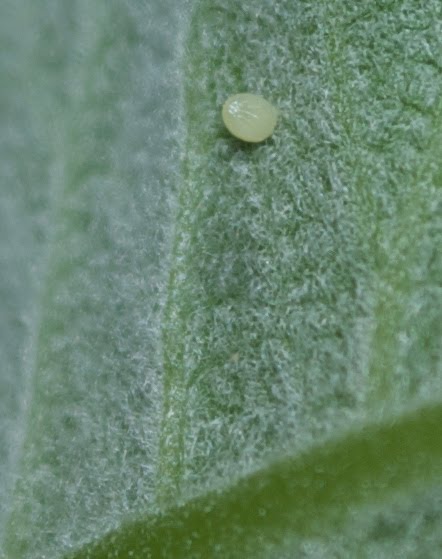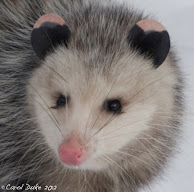I would like to share with you some of my observations over the years, while raising Monarch caterpillars. It is a truly wondrous wandering through days and weeks of change. Where else to begin but at the beginning . . . with an egg a bit larger than an aphid filled with an off white bundle just about to embark on a magical journey. A Monarch butterfly egg attached here by it's mother may appear still to those viewing its delicately etched casing.
There is constant movement of change going on within the hard protective shell, where there is a wax lining helping to keep the forming caterpillar moist. After a few days a teeny black head appears at the tip of the egg. With a magnifying glass I can see it moving and soon it cleverly carves an exit hole through the shell.
Once the little ivory creature emerges it makes breakfast of the entire nutritious casing . . . nothing is wasted and it leaves hardly a trace of its former vessel. Free of its tight quarters like a jack-in-the-box granted liberty, the one twenty-fifth of an inch long caterpillar begins to explore its new world.
The female Monarch usually lays one egg to one Milkweed plant. I most often find them on the fuzzy underside of the leaves. Sometimes there are two or more fastened to one plant. They can be found on the upper or under sides of leaves and on the dangling pink Milkweed florets . . . or even the seed pods. If the mother is in a hurry almost anywhere on the Milkweed plant will have to do. There is much danger lurking about the plant too. I have seen small white spiders camped out near other intricate Monarch domes . . . in wait for what it considers a delicious morsel . . . the unknowing cater . . . to evacuate its finely ridged eggshell.
This egg is merely a empty clear casing. The female butterfly carries anywhere from 300 to 700 eggs and sometimes they are not all 'good eggs'.
The vulnerable caterpillar moves through the hairy landscape of leaf, likened to a silver glade or meadow, over streams and tributaries of milk. First, it grazes on milkweed hairs, thereby making a clearing to the leaf surface. Carefully, it must begin to nibble a hole that will not open a large stream. The caterpillar is so small it chews between the veins of milk-like fluid and is not caught in a flood.
A tiny hole soon appears on the leaf. It will grow in size as the skilled leaf cutter persists, and bite-by-bite, the caterpillar grows larger itself. I look through the minuscule hole with my magnifying glass and see the tiny, shinny, inky, black head meticulously cutting parenthesis shaped slices with the same determined spirit as its mothers, when she carried our her destiny. Within a day or so we begin to see the colors of the cater emerging. I think it such a cute little fellow.
Like most young, there is the need for quiet time and I do find the little ones napping a good bit between molts. After a couple of days steadily eating and resting, hidden in the down-like fuzz of the leaf, the caterpillar is nearly ready for its first molt. The Monarch caterpillar does not have a skeleton but an exoskeleton or cuticle, which protects the inner soft parts of the caterpillar. This hard skin cannot stretch to allow it to grow, so the caterpillar must molt, or shed its skin, five times before it becomes a butterfly.
Here we find our little ward just after its first molt. Note the once solid black-patent head is now covered in a design.
Often we will find these toddler caters near the top of the plant munching on the young tender leaves. The scientific term for caterpillar is larva and comes from the Latin meaning ghost and mask. Truly the small creature is masking a notable transformation, for while it is a caterpillar it is always becoming a butterfly. Inside, its body cells and hormones are casting the parts it plays simultaneously. The caterpillar grows larger on the outside with each molt, while its inner parts evolve towards its fascinating metamorphosis.
This little face mask reminds me of a fencing mask. It often looks as though the cater could fall off the surface but when the caterpillar crawls, it holds onto a leaf or stem with all sixteen legs. Each proleg has numerous minuscule hooks called crochets, which cling to the leaf and the silk thread the caterpillar spins, along the way, allowing the caterpillar to reach out with its six true legs to seek higher or lower ground. The silk is spun by the spinneret and gives the little caterpillar something more to grasp while moving around on a leaf. Similar to a rock climber, the caterpillar can also drop a silk line and move quickly down from one leaf to another.
Here the little face mask is somehow still attached to the new face. The secure little cater works hard to be rid of it. It is also quite a labor to take off the old tight dress. Note how the short tentacles are all slicked back . . . like an Elvis hair do.
The yellow and white stripes are the actual caterpillar but the black stripes are part of the clear skin. Here the tentacles are perked up and we can see the face is actually yellow.
The Monarch caterpillar has three separate body parts; a head, thorax and an abdomen. The head has twelve simple or weak eyes called ocelli, two small antennae, mouthparts, which include an upper and lower lip with strong jaws or mandibles, scent/sensory organs called maxillary palpi and a spinneret for spinning silk. The thorax has six true legs while the abdomen displays ten prolegs also called false legs, as they do not stay with the caterpillar when it becomes a butterfly. The last two prolegs are also named claspers and they play a most important role in the caterpillar’s life.
These tiger striped caterpillars to me are the true heros of what we all admire in their later self. They are steadfast towards their purpose and constantly continue nurturing what they are becoming. I do not believe they get their due. I have harvested small Milkweed plants growing in harms way along the paths and have enjoyed the ritual of raising these magical creatures for nearly thirty years. I have written a book proposal of their metamorphosis that was consider a narrow slice of a narrow topic . . . so no book was born, but the joy continues. Now I am at risk of creating doubt in some of my readers . . . I admit to being slightly obsessive here, for I love the metaphor to our own struggles in life . . . to our striving to become who we really are. I find these amazing caters inspiring in how they pursue their goals and will continue with a few more post to show . . . the complete metamorphosis of the Monarch Butterfly. One thing to keep in mind is the size of the tentacles. They will double in size before the final molt into a jewel-like chrysalis. This fellow has more molts to go before he hangs in a 'J' and begins the final transformation towards the end of its life journey. Then that too will be a new beginning .








































































.jpg)





































































